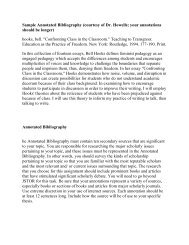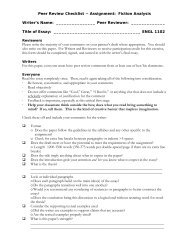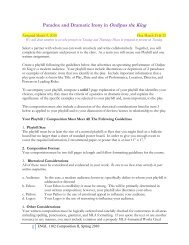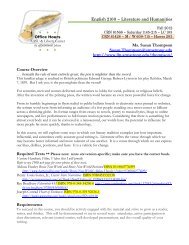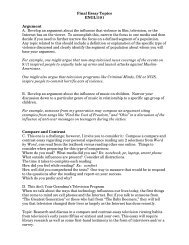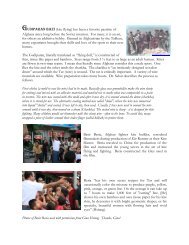Thompson Fiction Analysis ENGL 1102 Handout
Thompson Fiction Analysis ENGL 1102 Handout
Thompson Fiction Analysis ENGL 1102 Handout
You also want an ePaper? Increase the reach of your titles
YUMPU automatically turns print PDFs into web optimized ePapers that Google loves.
<strong>Thompson</strong><br />
<strong>Fiction</strong> <strong>Analysis</strong><br />
<strong>ENGL</strong> <strong>1102</strong> <strong>Handout</strong><br />
Introduction & Conclusion Tips<br />
• Introduction<br />
o Include the name of the short story and the author<br />
o Where are you going with this paper?<br />
o Include a well-worded thesis statement that clearly identifies your goal with this<br />
paper<br />
Go to the end of this document for tips on writing a good thesis.<br />
• Body of Paper<br />
o Develop your analysis in a logical order<br />
o Be sure that your thoughts flow smoothly from paragraph to paragraph in an order<br />
that the reader can follow with a clear understanding of why your thoughts are<br />
ordered in the way you present them<br />
• Conclusion<br />
o Summarize your interpretations and insights<br />
o This is the ideal place to offer an opinion, if you feel so inclined<br />
o Your paper must arrive at a logical, proven, and thoroughly discussed conclusion<br />
o Do not restate your thesis statement word-for-word in the conclusion<br />
Tips For Writing a Character <strong>Analysis</strong><br />
These recommendations are useful for any analysis on which you work<br />
• Read the story once to formulate a basic opinion<br />
• Read the story again, annotating the text<br />
• Read your annotations; sort your notes into one of these categories related to character<br />
analysis; remember, all stories have strengths and weaknesses<br />
o Appearance<br />
o Speech<br />
o Actions<br />
o Words of Others<br />
o Environment<br />
o<br />
o<br />
Thoughts/Feelings<br />
Devices<br />
• Metaphor<br />
• Simile<br />
• Foreshadowing<br />
• Use your list<br />
• Prewrite<br />
o Revise your notes into paragraphs about each of the areas above and include<br />
quotes from the text that back up your ideas<br />
• In the least, make a note of the page numbers where the quotes are so you<br />
don’t forget to properly cite within the text
o<br />
o<br />
o<br />
o<br />
o<br />
• Once you get your thoughts down on paper, select the ones from which<br />
you can get the most mileage; but, don’t trash anything yet; you may need<br />
these<br />
Read your notes carefully and discuss what these examples tell you about the<br />
character and how it is important to the story<br />
Many of these ideas will make super topic sentences for your paragraphs; make<br />
good use of them<br />
Order or reorder your ideas<br />
• Your first draft is seldom in the most logical order<br />
Get it into some order and type it up<br />
Revise for clarity<br />
• Omit unnecessary words<br />
• Strive for conciseness<br />
• If you are are constant comma user, stop – revise those sentences, even if<br />
it means breaking them into shorter sentences. It is better to go back and<br />
create correct compound or complex sentences than use so many commas<br />
your grade suffers<br />
A few more tips: Characterization, Point of View, & Structure<br />
These are only a few of the many terms that you need to complete an analysis.<br />
Your text and the handout I gave you offer definitions and examples of theme, characterization,<br />
thematic elements, setting, irony, symbolism, plot, and many, many more.<br />
I advise you to focus on one to three at the absolute most. The current assignment is a short<br />
paper, so don’t take on too many terms. You will, of course, refer to other terms as you relate<br />
how the topic you are discussing contributes to the story and the point you are making. In other<br />
words, if you complete a character analysis, you will discuss how the character develops in<br />
relationship to the plot; however, you will not be completing a plot analysis in the process.<br />
Characterization<br />
Characterization broadly refers to the description and development of characters. This describes<br />
some of the terminology writers and critics use to discuss a narrower and more conventional<br />
sense of characterization.<br />
Primary and Secondary Characters<br />
• The primary characters drive the story<br />
• The primary character develops and the reader should recognize the changes or<br />
development in relationship to the action of the story<br />
• Another way to say this is that primary characters are generally dynamic, or changeable,<br />
whereas secondary characters are generally static, or unchanging<br />
• Secondary characters help create the circumstances surrounding the transformations of<br />
the primary character<br />
• You may add a third category that is something like "extras" in films--the minor and<br />
sometimes nameless characters that add functional realism but nothing else
Direct and Indirect Characterization<br />
• Direct characterization tells the reader about a character; indirect characterization shows<br />
a character in action and leaves the reader to infer the rest.<br />
Point of View<br />
• Point of view describes the perspective from which a piece of fiction is told. Remember<br />
that a single work of fiction can have many narrators and many points of view.<br />
What About First Person, Second Person, Third Person?<br />
• Most authors of fiction choose either first-person narration or third-person narration.<br />
• The first-person narrator speaks as "I."<br />
• Narration in the third person describes action from a more detached perspective. In thirdperson<br />
narration, characters will appear by their names or the third-person pronouns (he,<br />
she, and they).<br />
• Rarely, the writer may choose second-person narration, which directs the story at "you,"<br />
the reader<br />
Subjectivity Objectivity Omniscience<br />
A point of view can be objective or subjective, limited or omniscient (all-knowing).<br />
• Subjective narrators generally speak in the first person and are necessarily limited<br />
because they offer one of many possible perspectives on the action they describe. They<br />
often participate directly in that action. Unreliable narrators are subjective, though<br />
subjective narrators are not necessarily unreliable.<br />
• Objective narrators act as observers.<br />
• An omniscient narrator has access to all the actions and thoughts of the story<br />
• A limited narrator will "know" only some of them<br />
Structure<br />
Structure does not mean that fiction is composed or comes together successfully by formula.<br />
These elements of structure help us understand some of the ways in which fiction writers shape<br />
elements such as character and setting.<br />
Story and Plot<br />
We use these terms broadly. The story is a narrative of events arranged in a sequence. Plot is<br />
also a narrative, but the emphasis is on cause. The plot is often an aspect of the story that causes<br />
you, the reader, to ask “and then?”<br />
Story is driven by events alone; plot by events and motivations.<br />
Theme and Meaning<br />
Theme is the main idea explored in the story.<br />
Flannery O’Connor says in “Writing Short Stories,” "I prefer to talk about the meaning in a<br />
story rather than the theme of a story. People talk about the theme of a story as if the theme were<br />
like the string that a sack of chicken feed is tied with. They think that if you can pick out the<br />
theme, the way you pick the right thread in the chicken-feed sack, you can rip the story open and<br />
feed the chickens. But this is not the way meaning works in fiction.”
"When you can state the theme of a story, when you can separate it from the story itself, then<br />
you can be sure the story is not a very good one. The meaning of a story has to be embodied in it,<br />
has to be made concrete in it. A story is a way to say something that can't be said any other way,<br />
and it takes every word in the story to say what the meaning is. You tell a story because a<br />
statement would be inadequate. When anybody asks what a story is about, the only proper thing<br />
is to tell him to read the story. The meaning of fiction is not abstract meaning but experienced<br />
meaning, and the purpose of making statements about the meaning of a story is only to help you<br />
to experience that meaning more fully."<br />
Conflict, Climax, and Resolution<br />
The collision of forces, like characters who have motives that are contrary to one another,<br />
produces conflict.<br />
Normally, conflict will gradually increase until the climax arrives. The climax is the point at<br />
which some event or decision turns the action of the narrative and releases the building tension.<br />
The resolution brings it all to some kind of conclusion. Remember, the resolution of the story<br />
does not necessarily mean that the conflicts are resolved, only that the narrative is complete.<br />
Epiphany<br />
Epiphanies, or realizations, are common but not necessary elements of works of fiction. In other<br />
words, your protagonist may not experience an epiphany.<br />
Place and Time<br />
Setting<br />
The setting is the context surrounding the characters. Analyze elements of the setting to<br />
determine their importance to the plot. Setting includes:<br />
• Physical environment<br />
• Time period<br />
• Emotional atmosphere<br />
Summary and Flashback<br />
Think about it: fictional time differs from "clock time" or "real time."<br />
A great example of this is the TV series 24 that begins with a summary of past events and then<br />
portrays events that supposedly happen in "real time" that a digital clock occasionally registers.<br />
Shakespeare's plays generally open with secondary characters providing summary of past events.<br />
Flashback uses a character's memory to give the reader details from an earlier time that<br />
contributes something to the main action.<br />
Writing a Solid Thesis<br />
1. Brainstorm the topic; do this on a piece of paper in the form of an outline or flow chart<br />
2. Narrow the topic so that you can thoroughly address it within the guidelines of the paper<br />
3. Understand your position on the topic; what do you want to say?<br />
4. Use specific language; utilize the appropriate terminology<br />
5. Remember you must support what you claim with examples
Your thesis is the guide to your paper. Almost all assignments can be reduced to a single<br />
question or statement. This does not mean that your thesis should be stated as a question. For<br />
this class, please do not state your thesis as a question.<br />
Ask yourself:<br />
What am I going to try to prove in this essay?<br />
In what order do I think I need to discuss my talking points?<br />
A strong thesis statement takes some sort of stand and states what the paper is about.<br />
Weak:<br />
Strong:<br />
There are some negative and positive aspects to drinking pomegranate juice.<br />
Because the antioxidant properties in pomegranate juice are necessary in a hearthealthy<br />
diet, cardiologists recommend that patients drink one eight ounce glass each<br />
day.<br />
A strong thesis statement inspires further discussion<br />
Your thesis needs to indicate your discussion points; don’t make the reader guess.<br />
Weak:<br />
Strong:<br />
Welty created a great character in Phoenix Jackson.<br />
Once assembled, each characteristic Welty carefully assigned Phoenix Jackson in<br />
“A Worn Path” results in a puzzle-like glimpse into the struggles, assumptions, and<br />
life of an elderly black woman in 1941 traveling the same worn path that her<br />
ancestors walked in an on-going search for equality.<br />
A strong thesis statement leaves the reader with a clear understanding of the purpose of the<br />
paper<br />
Weak: Companies need to exploit the marketing potential of the Internet and Web pages<br />
can provide advertising and customer support.<br />
If you read the above sentence, you may ask, is this about the potential of the Internet or is it<br />
about the pros and cons of creating a Web page?<br />
Strong:<br />
Because the Internet offers a variety of marketing venues, companies should<br />
explore its potential by using Web pages that offer a variety of services and<br />
opportunities.



